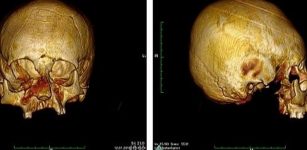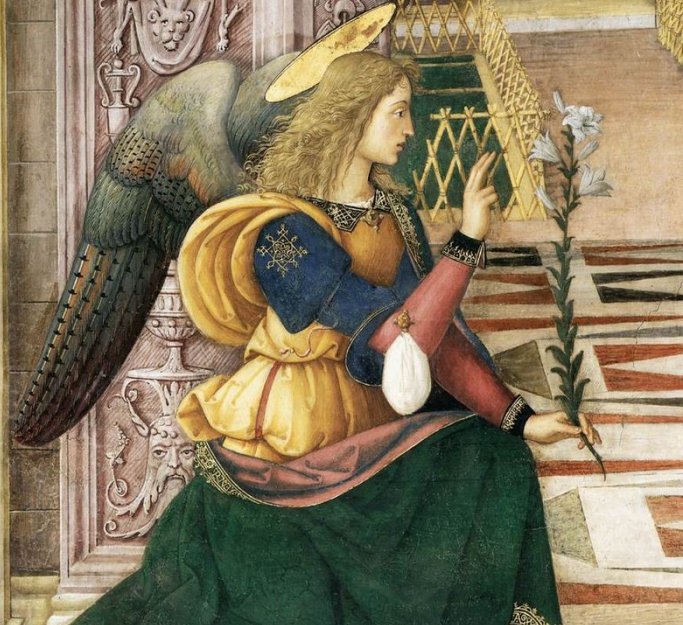Mystery Of The Second Gabriel Stone And The Man Resurrected By Archangel Gabriel
A. Sutherland - AncientPages.com - In the three monotheistic faiths, Gabriel's role - as a messenger to humans from God - was crucial.
The angel Gabriel (“man of God” or “strength of God”) is remembered as the angel who told Mary she would give birth to the Son of God, as the angel of the annunciation. Gabiel is the one who revealed that the Savior was to be called “Jesus” (Luke 1:31) but his first biblical appearance is recorded in Daniel 8:16, when he is told to explain a vision to the prophet.
No doubt, all artifacts that can be related to the angel Gabriel, who was entrusted to deliver many important messages on God’s behalf, have great significance to researchers dealing with biblical archaeology.
Apocalyptic text is inscribed with ink in Hebrew over a large stone. It's the Gabriel Revelation - first published in 2007.
It was discovered around the year 2000 in Jordan near the eastern shore of the Dead Sea.
The so-called Gabriel Stone is authentic and very important for understanding the true roots of Jesus Christ's messianic conception.
However, this ancient tablet with messianic overtones, which according to general beliefs, originates from before the time of Christ, has been debated in archaeological and biblical circles.
While one scholar claims the find could “shake our basic view of Christianity,” a Catholic Professor of Scripture suggests the tablet is actually evidence for the historical probability of Christian belief.
Gabriel Stone remains a priceless and unique 2,000-year-old stone artifact, which traces depictions of the Archangel Gabriel in Jewish, Christian and Islamic sacred writings scriptures. The stone is cut on one side, along which two columns - 16 cm wide and about 75 cm in height - are covered with text.
The columns are separated by a gap approximately 3.5 cm wide.
See also:
Qumran: The Dead Sea Scrolls And Their Connection To Enigmatic Essenes
Baffling Copper Scroll – A Treasure Map Leading To A Secret Lost Temple?
Biblical City Of Gezer: Important Ancient City Mentioned In The Amarna Letters
The inscription is composed of 47 horizontal lines and four vertical lines fixing the columns' borders.
A three-foot-tall tablet contains the text composed of 87 lines of which 44 are in the right-hand column and 43 in the left-hand column. The last two lines of the left-hand column are much shorter than the rest, and their ending is marked by diagonal lines.
It's uncertain if the text begins with the first line of the right-hand column. Was it preceded by text that is now lost? Or was it so that the whole composition was comprised of an additional stone or perhaps even more stones?
However, no traces of binding substance (like for example cement) was discovered by archaeologists on it.
The Hebrew text is written in the first person that identifies himself three times in the first-person: "I am Gabriel". He converses with a human figure – a visionary or prophet – to whom he, Gabriel, is apparently communicating a vision.
The text - very prophetic and apocalyptic - also expresses anxiety over the fate of Jerusalem and reflects the crucial role of angels as intermediaries. It's an attack on Jerusalem and the hope that God will see to the city's deliverance for the sake of his servant David, perhaps referring to the Messiah of Davidic descent.
The Gabriel Revelation stone is believed to be the first example of the angel's name appearing in ink on stone, although earlier mentions of his name are found in the Dead Sea scrolls.
At the same time, museum director James Snyder said that "the Gabriel Revelation stone is, in a way, like a Dead Sea scroll written on stone and it's unique in that respect."
Controversy over the exact nature of the stone's text remains. The second or even several "Gabriel Stone" fragments may still be out there, waiting to be discovered.
Based on analysis of linguistic patterns and the shape of the script of The Gabriel Revelation stone, the inscription is a pre-Christian text, written at the end of the first century BC (around the time of Jesus Christ's birth).
The first part of the sacred inscription has the apocalyptic character; it's about the ultimate destiny of mankind and the world; vanquishing of the Antichrist and its forces of evil. The second part focuses on death and resurrection. The text refers to three leaders - shepherds - sent by God to His people, who were killed in battle.
Interesting are the words in the last part of the inscription. These words are the words of the Archangel Gabriel who orders his mysterious and unknown interlocutor - to return to life after three days and says: "By three days, live."
The Gabriel's order written in the 80th line of the inscription, is followed by the further line that states that a leader - a "prince of the princes" - was put to death, and his corpse turned to dung among the rocky crevices.
Researchers have long debated: who is the man resurrected by Archangel Gabriel?
Written by – A. Sutherland AncientPages.com Senior Staff Writer
Copyright © AncientPages.com All rights reserved. This material may not be published, broadcast, rewritten or redistributed in whole or part without the express written permission of AncientPages.com
Expand for referencesMore From Ancient Pages
-
 10 Great Ancient Mysteries Of Africa
Civilizations | Mar 12, 2017
10 Great Ancient Mysteries Of Africa
Civilizations | Mar 12, 2017 -
 60-Meter Longhouse Discovered Near Viking Ship At Gjellestad, Norway
Archaeology | Dec 6, 2021
60-Meter Longhouse Discovered Near Viking Ship At Gjellestad, Norway
Archaeology | Dec 6, 2021 -
 Triskelion – Millennia Old Traditional Symbol Used In Many Cultures Around The World
Ancient Symbols | Dec 13, 2018
Triskelion – Millennia Old Traditional Symbol Used In Many Cultures Around The World
Ancient Symbols | Dec 13, 2018 -
 Secrets Of The Two Half Crescent Moons And The Serpent People
Ancient Mysteries | Jan 23, 2020
Secrets Of The Two Half Crescent Moons And The Serpent People
Ancient Mysteries | Jan 23, 2020 -
 Discovery Of An Unusually Large Ancient Artifact May Confirm Powerful Myth Of A Mysterious Race
Featured Stories | Oct 8, 2024
Discovery Of An Unusually Large Ancient Artifact May Confirm Powerful Myth Of A Mysterious Race
Featured Stories | Oct 8, 2024 -
 When And Why Negev Highlands’ Agricultural Settlement Was Abandoned? – Researchers Have Answers
Archaeology | Jul 28, 2020
When And Why Negev Highlands’ Agricultural Settlement Was Abandoned? – Researchers Have Answers
Archaeology | Jul 28, 2020 -
 Unique Chinchorro Burial Tradition For All And Ancient Egyptians Who Mummified Kings And Nobles Only
Ancient Traditions And Customs | Nov 1, 2017
Unique Chinchorro Burial Tradition For All And Ancient Egyptians Who Mummified Kings And Nobles Only
Ancient Traditions And Customs | Nov 1, 2017 -
 Star-Shaped Magnetic Anomaly At Hidden Stone Circle In The Outer Hebrides Gives New Insight Into Ancient Beliefs
Archaeology | Jan 2, 2020
Star-Shaped Magnetic Anomaly At Hidden Stone Circle In The Outer Hebrides Gives New Insight Into Ancient Beliefs
Archaeology | Jan 2, 2020 -
 William The Conqueror: Ruthless And Powerful Ruler Who Changed Britain Forever
Featured Stories | Feb 25, 2023
William The Conqueror: Ruthless And Powerful Ruler Who Changed Britain Forever
Featured Stories | Feb 25, 2023 -
 3,000-year-old pottery found in Papua New Guinea’s highlands
News | Sep 3, 2015
3,000-year-old pottery found in Papua New Guinea’s highlands
News | Sep 3, 2015 -
 Grandfather Frost And Snow Maiden Bring Gifts On New Year’s Eve
Christmas Traditions | Dec 31, 2024
Grandfather Frost And Snow Maiden Bring Gifts On New Year’s Eve
Christmas Traditions | Dec 31, 2024 -
 Native Americans And European Legends Tell Peculiar Beings From The Sky Still Live On The Earth
Ancient Mysteries | May 16, 2018
Native Americans And European Legends Tell Peculiar Beings From The Sky Still Live On The Earth
Ancient Mysteries | May 16, 2018 -
 Oldest Known Evidence Of Artificial Cranial Deformation Revealed In Croatia
Archaeology | Aug 26, 2019
Oldest Known Evidence Of Artificial Cranial Deformation Revealed In Croatia
Archaeology | Aug 26, 2019 -
 Surprising Inscription Discovered On Birka Ring – Ancient Viking Artifact
Archaeology | May 13, 2015
Surprising Inscription Discovered On Birka Ring – Ancient Viking Artifact
Archaeology | May 13, 2015 -
 What Was Life Like For Children In Ancient Athens?
Ancient History Facts | Jul 4, 2018
What Was Life Like For Children In Ancient Athens?
Ancient History Facts | Jul 4, 2018 -
 Huge Folklore Map With Supernatural Beings And Mythical Monsters Created – Available For Free Online
Folklore | Jan 7, 2025
Huge Folklore Map With Supernatural Beings And Mythical Monsters Created – Available For Free Online
Folklore | Jan 7, 2025 -
 Mysterious Tiny 1,400-Year-Old Gold Foil Figures Found In Pagan Temple
Archaeology | Sep 23, 2023
Mysterious Tiny 1,400-Year-Old Gold Foil Figures Found In Pagan Temple
Archaeology | Sep 23, 2023 -
 Is A Viking Settlement And An Even Older Church Hidden Under St. Clement’s Church In Norway?
Archaeology | Apr 13, 2017
Is A Viking Settlement And An Even Older Church Hidden Under St. Clement’s Church In Norway?
Archaeology | Apr 13, 2017 -
 Beautiful 2,300-Year-Old Gold Ring Found In The City Of David
Archaeology | May 30, 2024
Beautiful 2,300-Year-Old Gold Ring Found In The City Of David
Archaeology | May 30, 2024 -
 Harem Conspiracy – Plot To Murder Ramesses III, The Last Great Warrior Pharaoh
Featured Stories | Mar 24, 2018
Harem Conspiracy – Plot To Murder Ramesses III, The Last Great Warrior Pharaoh
Featured Stories | Mar 24, 2018




